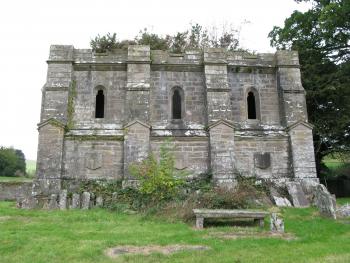Item Details

Work details
- Title
- Monzievaird Parish Church
- Work OCR text
SUMMARY DESCRIPTION
The mausoleum of the Murray of Ochtertyre family is said to be on the site of the medieval parish church. Nothing is known of the medieval building.
HISTORICAL OUTLINE
Monzievaird appears to have been amongst the churches apparently granted to Inchaffray by Gillebrigte, earl of Strathearn, around the time of his refoundation of the monastery as an Augustinian priory in 1200. The earl’s charter has not survived and the church is not listed in Pope Innocent III’s 1203 confirmation of the abbey’s possessions, but in April 1203 or 1204 King William confirmed its gift to Inchaffray by the earl.(1) It is stated in a concordance between Bishop Clement of Dunblane and the canons of Inchaffray in 1234 that the canons had not yet gained full corporal possession, but the implication in the agreement is that full appropriation is expected to follow.(2) In 1239, a vicarage settlement for ten churches in Strathearn, including Monzievaird, was confirmed by the dean and chapter of Dunblane, with the whole fruits of the church being appropriated to the canons.(3) It appears from that settlement that a vicarage pensionary was intended to serve the parochial cure, an arrangement which it has been suggested continued at the time of the Reformation.(4) A vicar of Monzievaird, however, is on record in September 1395,(5) and in 1445 the then incumbent was described as holder of the vicarage perpetual of the church.(6) The vicarage was held at the Reformation by sir Thomas Cristesoun, who had set it at a rental of £10 annually to the younger brother of Patrick Murray of Ochtertyre.(7) In 1569-72, William Drummond was serving as minister for the parishes of Crieff, Strageath, Comrie, Monzievaird and Tullicheddill.(8)
In c.1495, the church was the scene of one of the worst outrages perpetrated in an escalating feud between the Drummonds and the Murrays over control of local properties and offices. A party of Drummonds led by Lord Drummond’s son had pursued a number of Murrays who took refuge in the church and, blocking all exits, had burned them to death in the building. In October 1495, King James IV granted a remission from outlawry to John, son of William Drummond and eleven other Drummonds for the burning of the church and the slaughter committed there, ‘howbeit that thai were Innocent thereof as is allegit, nevirtheles for the fere and terror that thai had at that tyme thai removit and past furth of our realme and therefore were put to our horne.’(9)
ARCHITECTURAL ANALYSIS
The parish was united with that of Strowan at a date likely to have been before 1662, with worship apparently then continuing at Monzievaird rather than Strowan. However, the church site was within an area that was eventually absorbed into the extensive policies of Ochtertyre House, and it was replaced by a new building about three kilometres to its west in 1803-4; that latter church has itself now been largely demolished. The site of the medieval church is said to have been subsequently overlain by the substantial mausoleum of the Murrays of Ochtertyre, which was built to the designs of C.H. Tatham in 1809. Although the dimensions of the mausoleum (the core within the buttresses measures 10.5 by 5.6 metres) are likely to be less than those of the medieval church, no traces of that church are to be seen around its perimeter. Nevertheless, the likelihood that this was the historic location for the parish church is supported by the survival of a number of eighteenth-century memorials.
NOTES
1. Inchaffray Charters, no XXII; RRS, ii, no 439.
2. Inchaffray Charters, no LXI.
3. Inchaffray Charters, no LXVII.
4. RMS, iv, no 2061.
5. CPL, Benedict XIII, 46-7.
6. CSSR, iv, no 1172.
7. Kirk (ed.), Book of Assumptions, 300.
8. Donaldson (ed.), Thirds of Benefices, 250.
9. NAS GD160/528/6.
BIBLIOGRAPHY
Calendar of Papal letters to Scotland of Benedict XIII of Avignon, 1976, ed. F. McGurk, (Scottish History Society) Edinburgh, 46-7.
Calendar of Scottish Supplications to Rome 1433-47, 1983, ed. A.I. Dunlop and D MacLauchlan, Glasgow, no 1172.
Charters, Bulls and other Documents relating to the Abbey of Inchaffray, 1908, (Scottish History Society), Edinburgh nos XXII, LXI, LXVII.
Cowan, I.B., 1967, The parishes of medieval Scotland, (Scottish Record Society), Edinburgh, 151.
Donaldson, G. 1949, Accounts of the collectors of thirds of benefices, (Scottish History Society), Edinburgh, 250.
Gifford, J., 2007, The Buildings of Scotland, Perth and Kinross, New Haven and London, 562.
Kirk, J, (ed), 1995, The Books of assumption of the thirds of benefices, (British Academy) Oxford, 300.
New Statistical Account of Scotland, 1845, Edinburgh and London, x, 735-6.
Regesta Regum Scottorum, Acts of William I (1165-1214), 1971, Edinburgh, no 439.
Registrum Magni Sigilli Regum Scotorum, 1886, iv (1546-1580), Edinburgh, no 2061.
Royal Commission on the Ancient and Historical Monuments of Scotland, Canmore database.
Statistical Account of Scotland, 1791-9, ed. J. Sinclair, Edinburgh, viii (1793), 574.
- Work Additional Notes
Dedication: St Serf/Servanus
Diocese: Diocese of Dunblane
County: County of Perthshire
Council: Perth and Kinross Council
OS: NN 8503 2344?
Image details
- Description
- 2. Monzievaird Churchyard, Ochtertyre mausoleum 1
- Full Image Dimensions (WxH)
- 4000x3000 pixels
- Accession Number
- IDB-124289-000733
- Collection
- Corpus of Scottish medieval parish churches





